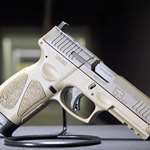
Manufacturers discontinue handgun models for a variety of reasons, all of which are based in the market. It’s as plain as the laws of supply and demand, to which I was once exposed in Economics 101, many years ago. I hope that long ago professor will excuse my clumsy summary of how it works, but here goes. A handgun is a product just like a box of matches or an exotic silk scarf. The handgun, match or scarf maker produces these things at some expense, in the hopes that he or she will sell them for more than it cost to make them. He’s free to ask any price, but is well advised to set the price with care. Too high and the product won’t sell; too low and he’s literally giving his profit away. If enough people want the handgun, matches or scarf, and he prices accurately, he will prosper. He has to consider many other factors, such as the cost of selling the product, a mercurial market and politicians messing around with the conditions under which he is allowed to sell his wares. Let’s take a look at a couple of guns that were discontinued, and then later revived.
As America faced the reality of an imminent war with the Axis powers in the late 30s and early 40s, our arms makers looked at their product lines and their manufacturing capability. One such firm was Colt, maker of mostly handguns, including the U.S. service pistol—the M1911A1. They also had production lines up-and-running to makes a variety of revolvers. One of these was the beloved Peacemaker, which had been (in 1940) made under the Blue Dome on the Connecticut River for 67 years. Not surprisingly, World War II caused Colt management to shut down the Model P line and store the equipment. When the war was over, they made it official by announcing the discontinuation of this gun. But in the mid-50s, when Americans began to watch lots of movie westerns, thereby creating a demand for the old guns. Colt gauged the depth and width of this demand carefully and decided to bring it back. It was a sound decision, because they have made more of them since the 1956 re-introduction than they did before, even though they cost more. There was a demand; Colt created a supply. And the gun is still in the catalog, as of 2013.
Meanwhile, upriver from Hartford and Colt, there was another maker trying to continue in the gun business. Smith & Wesson came off some hard times during WWII, but an aggressive new president was making big waves in an effort to grow the company. He actively looked for new models and therefore listened as handgun experts Rex Applegate and W.H.B. Smith came to his office. Applegate wanted a new solid-frame version of the Safety Hammerless in .38 Spl The reason for his demand is an oft-repeated chunk of handgun lore. Rex felt there was a need for the gun and S&W’s Carl Hellstrom agreed. The revolver (based on the new J frame) was successful. After some fifteen years of popularity, S&W chose to shorten up the revolver line and discontinued a bunch of classics, including both aluminum and steel-frame versions of the Centennial. No sooner has this happened than second market specimens of the gun began to increase in price—clearly a demand with small supply. Therefore, S&W re-introduced an improved version with no grip safety in 1989. That revolver, in several calibers and variations, is now one of the sellers in S&W’s line.
Obviously, if enough handgunners want it, manufacturers will make it. The operative word here is enough. To get a discontinued model back in production, a maker has to be certain that there will be a strong immediate and continuing demand. That’s why, as much as you and I might want one, there is little chance that you will ever see new Pythons again.






































